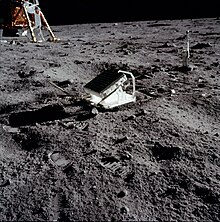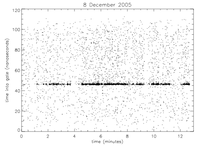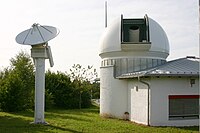Lunar Laser Ranging experiments

Lunar Laser Ranging(LLR) is the practice of measuringthe distancebetween the surfaces of theEarthand theMoonusinglaser ranging.The distance can be calculated from theround-trip timeoflaserlight pulses travelling at thespeed of light,which are reflected back to Earth by the Moon's surface or byone of severalretroreflectorsinstalled on the Moon. Three were placed by the United States'Apollo program(11,14,and15), two by the SovietLunokhod 1 and 2 missions,[1]and one by India'sChandrayaan-3mission.[2][3]
Although it is possible to reflect light or radio waves directly from the Moon's surface (a process known asEME), a much more precise range measurement can be made using retroreflectors, since because of their small size, the temporal spread in the reflected signal is much smaller[4]and because the return will be more evenly reflected with less diffusion.
Laser ranging measurements can also be made with retroreflectors installed onMoon-orbiting satellitessuch as theLRO.[5][6]
History[edit]


The first successful lunar ranging tests were carried out in 1962 whenLouis SmullinandGiorgio Fioccofrom theMassachusetts Institute of Technologysucceeded in observing laser pulses reflected from the Moon's surface using a laser with a 50J 0.5 millisecond pulse length.[7]Similar measurements were obtained later the same year by a Soviet team at theCrimean Astrophysical Observatoryusing aQ-switchedruby laser.[8]
Shortly thereafter,Princeton Universitygraduate studentJames Fallerproposed placing optical reflectors on the Moon to improve the accuracy of the measurements.[9]This was achieved following the installation of aretroreflectorarray on July 21, 1969 by the crew ofApollo 11.Two more retroreflector arrays were left by theApollo 14andApollo 15missions. Successful lunar laser range measurements to theretroreflectorswere first reported on Aug. 1, 1969 by the 3.1 m telescope atLick Observatory.[9]Observations fromAir Force Cambridge Research LaboratoriesLunar Ranging Observatory in Arizona, thePic du Midi Observatoryin France, the TokyoAstronomical Observatory,andMcDonald Observatoryin Texas soon followed.
The uncrewed SovietLunokhod 1andLunokhod 2rovers carried smaller arrays. Reflected signals were initially received fromLunokhod 1by the Soviet Union up to 1974, but not by western observatories that did not have precise information about location. In 2010NASA'sLunar Reconnaissance Orbiterlocated the Lunokhod 1 rover on images and in April 2010 a team from University of California ranged the array.[10]Lunokhod 2'sarray continues to return signals to Earth.[11]The Lunokhod arrays suffer from decreased performance in direct sunlight—a factor considered in reflector placement during the Apollo missions.[12]
The Apollo 15 array is three times the size of the arrays left by the two earlier Apollo missions. Its size made it the target of three-quarters of the sample measurements taken in the first 25 years of the experiment. Improvements in technology since then have resulted in greater use of the smaller arrays, by sites such as theCôte d'Azur ObservatoryinNice,France; and theApache Point Observatory Lunar Laser-ranging Operation(APOLLO) at theApache Point ObservatoryinNew Mexico.
In the 2010s severalnew retroreflectorswere planned. TheMoonLIGHTreflector, which was to be placed by the privateMX-1Elander, was designed to increase measurement accuracy up to 100 times over existing systems.[13][14][15]MX-1E was set to launch in July 2020,[16]however, as of February 2020, the launch of the MX-1E has been canceled.[17]India'sChandrayaan-3lunar lander successfully placed a sixth reflector on the Moon in August 2023.[3]MoonLIGHT will be launched in early 2024 with aCommercial Lunar Payload Services(CLPS) mission.[18]
Principle[edit]

The distance to the Moon is calculatedapproximatelyusing the equation: distance= (speed of light×duration of delay due to reflection) / 2.Since thespeed of lightis a defined constant, conversion between distance and time of flight can be made without ambiguity.
To compute the lunar distance precisely, many factors must be considered in addition to the round-trip time of about 2.5 seconds. These factors include the location of the Moon in the sky, the relative motion of Earth and the Moon, Earth's rotation,lunar libration,polar motion,weather,speed of light in various parts of air, propagation delay throughEarth's atmosphere,the location of the observing station and its motion due tocrustal motionandtides,andrelativistic effects.[20][21]The distance continually changes for a number of reasons, but averages 385,000.6 km (239,228.3 mi) between the center of the Earth and the center of the Moon.[22]The orbits of the Moon and planets are integrated numerically along with the orientation of the Moon called physicallibration.[23]
At the Moon's surface, the beam is about 6.5 kilometers (4.0 mi) wide[24][i]and scientists liken the task of aiming the beam to using a rifle to hit a movingdime3 kilometers (1.9 mi) away. The reflected light is too weak to see with the human eye. Out of a pulse of 3×1017photons[25]aimed at the reflector, only about 1–5 are received back on Earth, even under good conditions.[26]They can be identified as originating from the laser because the laser is highlymonochromatic.
As of 2009, the distance to the Moon can be measured with millimeter precision.[27]In a relative sense, this is one of the most precise distance measurements ever made, and is equivalent in accuracy to determining the distance between Los Angeles and New York to within the width of a human hair.
List of retroreflectors[edit]
List of observatories[edit]
The table below presents a list of active and inactive Lunar Laser Ranging stations on Earth.[22][28]
| Observatory | Project | Operating timespan | Telescope | Laser | Range accuracy | Ref. |
|---|---|---|---|---|---|---|
| McDonald Observatory,Texas, US | MLRS | 1969–1985
1985–2013 |
2.7 m | 694 nm, 7 J
532 nm, 200 ps, 150 mJ |
[29] | |
| Crimean Astrophysical Observatory(CrAO), USSR | 1974, 1982–1984 | 694 nm | 3.0–0.6 m | [30] | ||
| Côte d'Azur Observatory(OCA), Grasse, France | MeO | 1984–1986
1986–2010 2010–present (2021) |
694 nm
532 nm, 70 ps, 75 mJ 532/1064 nm |
[22][31] | ||
| Haleakala Observatory,Hawaii, US | LURE | 1984–1990 | 532 nm, 200 ps, 140 mJ | 2.0 cm | [22][32] | |
| Matera Laser Ranging Observatory (MLRO), Italy | 2003–present (2021) | 532 nm | ||||
| Apache Point Observatory,New Mexico, US | APOLLO | 2006–2021
2021–present (2023) |
532 nm, 100 ps, 115 mJ | 1.1 mm | [22] | |
| Geodetic Observatory Wettzell,Germany | WLRS | 2018–present (2021) | 1064 nm, 10 ps, 75 mJ | [34] | ||
| Yunnan Astronomical Observatory,Kunming, China | 2018 | 1.2 m | 532 nm, 10 ns, 3 J | meter level | [35] |
Data analysis[edit]
The Lunar Laser Ranging data is collected in order to extract numerical values for a number of parameters. Analyzing the range data involves dynamics, terrestrial geophysics, and lunar geophysics. The modeling problem involves two aspects: an accurate computation of the lunar orbit and lunar orientation, and an accurate model for the time of flight from an observing station to a retroreflector and back to the station. Modern Lunar Laser Ranging data can be fit with a 1 cm weighted rms residual.
- The center of Earth to center of Moon distance is computed by a program that numerically integrates the lunar and planetary orbits accounting for the gravitational attraction of the Sun, planets, and a selection of asteroids.[36][23]
- The same program integrates the 3-axis orientation of the Moon called physicalLibration.
The range model includes[36][37]
- The position of the ranging station accounting for motion due toplate tectonics,Earth rotation,precession,nutation,andpolar motion.
- Tides in the solid Earth and seasonal motion of the solid Earth with respect to its center of mass.
- Relativistic transformation of time and space coordinates from a frame moving with the station to a frame fixed with respect to the solar system center of mass. Lorentz contraction of the Earth is part of this transformation.
- Delay in the Earth's atmosphere.
- Relativistic delay due to the gravity fields of the Sun, Earth, and Moon.
- The position of the retroreflector accounting for orientation of the Moon and solid-body tides.
- Lorentz contraction of the Moon.
- Thermal expansion and contraction of the retroreflector mounts.
For the terrestrial model, the IERS Conventions (2010) is a source of detailed information.[38]
Results[edit]
Lunar laser ranging measurement data is available from the Paris Observatory Lunar Analysis Center,[39]the International Laser Ranging Service archives,[40][41]and the active stations. Some of the findings of thislong-term experimentare:[22]
Properties of the Moon[edit]
- The distance to the Moon can be measured with millimeter precision.[27]
- The Moon is spiraling away from Earth at a rate of3.8 cm/year.[24][42]This rate has been described as anomalously high.[43]
- The fluid core of the Moon was detected from the effects of core/mantle boundary dissipation.[44]
- The Moon has free physicallibrationsthat require one or more stimulating mechanisms.[45]
- Tidal dissipation in the Moon depends on tidal frequency.[42]
- The Moon probably has a liquid core of about 20% of the Moon's radius.[11]The radius of the lunar core-mantle boundary is determined as381±12 km.[46]
- The polarflatteningof the lunar core-mantle boundary is determined as(2.2±0.6)×10−4.[46]
- The free corenutationof the Moon is determined as367±100 yr.[46]
- Accurate locations for retroreflectors serve as reference points visible to orbiting spacecraft.[47]
Gravitational physics[edit]
- Einstein'stheory of gravity (thegeneral theory of relativity) predicts theMoon's orbitto within the accuracy of the laser ranging measurements.[11][48]
- Gauge freedomplays a major role in a correct physical interpretation of the relativistic effects in the Earth-Moon system observed with LLR technique.[49]
- The likelihood of anyNordtvedt effect(a hypothetical differential acceleration of the Moon and Earth towards the Sun caused by their different degrees of compactness) has been ruled out to high precision,[50][48][51]strongly supporting thestrong equivalence principle.
- The universal force ofgravityis very stable. The experiments have constrained the change inNewton'sgravitational constantGto a factor of(2±7)×10−13per year.[52]
Gallery[edit]
-
Apollo 14 Lunar Ranging Retro Reflector (LRRR)
-
APOLLOcollaboration photon pulse return times
-
Laser Ranging atGoddard Space Flight Center
See also[edit]
- Carroll Alley(first principal investigator of the Apollo Lunar Laser Ranging team)
- Lidar
- Lunar distance (astronomy)
- Satellite laser ranging
- Space geodesy
- Third-party evidence for Apollo Moon landings
- List of artificial objects on the Moon
References[edit]
- ^During the round-trip time, an Earth observer will have moved by around1 km(depending on their latitude). This has been presented, incorrectly, as a 'disproof' of the ranging experiment, the claim being that the beam to such a small reflector cannot hit such a moving target. However the size of the beam is far larger than any movement, especially for the returned beam.
- ^Chapront, J.; Chapront-Touzé, M.; Francou, G. (1999). "Determination of the lunar orbital and rotational parameters and of the ecliptic reference system orientation from LLR measurements and IERS data".Astronomy and Astrophysics.343:624–633.Bibcode:1999A&A...343..624C.
- ^"Chandrayaan-3".ISRO.Retrieved15 August2023.
- ^abDhillon, Amrit (23 August 2023)."India lands spacecraft near south pole of moon in historic first".The Guardian.Retrieved23 August2023.
- ^Müller, Jürgen; Murphy, Thomas W.; Schreiber, Ulrich; Shelus, Peter J.; Torre, Jean-Marie; Williams, James G.; Boggs, Dale H.; Bouquillon, Sebastien; Bourgoin, Adrien; Hofmann, Franz (2019)."Lunar Laser Ranging: a tool for general relativity, lunar geophysics and Earth science".Journal of Geodesy.93(11): 2195–2210.Bibcode:2019JGeod..93.2195M.doi:10.1007/s00190-019-01296-0.ISSN1432-1394.S2CID202641440.
- ^Mazarico, Erwan; Sun, Xiaoli; Torre, Jean-Marie; Courde, Clément; Chabé, Julien; Aimar, Mourad; Mariey, Hervé; Maurice, Nicolas; Barker, Michael K.; Mao, Dandan; Cremons, Daniel R.; Bouquillon, Sébastien; Carlucci, Teddy; Viswanathan, Vishnu; Lemoine, Frank; Bourgoin, Adrien; Exertier, Pierre; Neumann, Gregory; Zuber, Maria; Smith, David (6 August 2020)."First two-way laser ranging to a lunar orbiter: infrared observations from the Grasse station to LRO's retro-reflector array".Earth, Planets and Space.72(1): 113.Bibcode:2020EP&S...72..113M.doi:10.1186/s40623-020-01243-w.hdl:11603/19523.ISSN1880-5981.
- ^Kornei, Katherine (15 August 2020)."How Do You Solve a Moon Mystery? Fire a Laser at It".The New York Times.ISSN0362-4331.Retrieved1 June2021.
- ^Smullin, Louis D.; Fiocco, Giorgio (1962)."Optical Echoes from the Moon".Nature.194(4835): 1267.Bibcode:1962Natur.194.1267S.doi:10.1038/1941267a0.S2CID4145783.
- ^Bender, P. L.; et al. (1973)."The Lunar Laser Ranging Experiment: Accurate ranges have given a large improvement in the lunar orbit and new selenophysical information"(PDF).Science.182(4109): 229–238.Bibcode:1973Sci...182..229B.doi:10.1126/science.182.4109.229.PMID17749298.S2CID32027563.
- ^abNewman, Michael E. (26 September 2017)."To the Moon and Back… in 2.5 Seconds".NIST.Retrieved27 January2021.
- ^McDonald, K. (26 April 2010)."UC San Diego Physicists Locate Long Lost Soviet Reflector on Moon".University of California, San Diego. Archived fromthe originalon 30 April 2010.Retrieved27 April2010.
- ^abcWilliams, James G.; Dickey, Jean O. (2002).Lunar Geophysics, Geodesy, and Dynamics(PDF).13th International Workshop on Laser Ranging. 7–11 October 2002. Washington, D. C.
- ^"It's Not Just The Astronauts That Are Getting Older".Universe Today.10 March 2010.Retrieved24 August2012.
- ^Currie, Douglas; Dell'Agnello, Simone; Delle Monache, Giovanni (April–May 2011)."A Lunar Laser Ranging Retroreflector Array for the 21st Century".Acta Astronautica.68(7–8): 667–680.Bibcode:2011AcAau..68..667C.doi:10.1016/j.actaastro.2010.09.001.
- ^Tune, Lee (10 June 2015)."UMD, Italy & MoonEx Join to Put New Laser-Reflecting Arrays on Moon".UMD Right Now.University of Maryland. Archived fromthe originalon 22 March 2018.Retrieved21 March2018.
- ^Boyle, Alan (12 July 2017)."Moon Express unveils its roadmap for giant leaps to the lunar surface... and back again".GeekWire.Retrieved15 March2018.
- ^Moon Express Lunar Scout (MX-1E),RocketLaunch.Live, archived fromthe originalon 27 July 2019,retrieved27 July2019
- ^"MX-1E 1, 2, 3".Retrieved24 May2020.
- ^"NASA Payloads for (CLPS PRISM) CP-11".
- ^"Was Galileo Wrong?".NASA.6 May 2004.Archivedfrom the original on 30 April 2022.
- ^Seeber, Günter (2003).Satellite Geodesy(2nd ed.). de Gruyter. p.439.ISBN978-3-11-017549-3.OCLC52258226.
- ^Williams, James G.; Boggs, Dale H. (2020)."The JPL Lunar Laser range model 2020".ssd.jpl.nasa.gov.Retrieved24 May2021.
- ^abcdefgMurphy, T. W. (2013)."Lunar laser ranging: the millimeter challenge"(PDF).Reports on Progress in Physics.76(7): 2.arXiv:1309.6294.Bibcode:2013RPPh...76g6901M.doi:10.1088/0034-4885/76/7/076901.PMID23764926.S2CID15744316.
- ^abPark, Ryan S.; Folkner, William M.; Williams, James G.; Boggs, Dale H. (2021)."The JPL Planetary and Lunar Ephemerides DE440 and DE441".The Astronomical Journal.161(3): 105.Bibcode:2021AJ....161..105P.doi:10.3847/1538-3881/abd414.ISSN1538-3881.S2CID233943954.
- ^abEspenek, F. (August 1994)."NASA – Accuracy of Eclipse Predictions".NASA/GSFC.Retrieved4 May2008.
- ^"The Basics of Lunar Ranging".Retrieved21 July2023.
- ^Merkowitz, Stephen M. (2 November 2010)."Tests of Gravity Using Lunar Laser Ranging".Living Reviews in Relativity.13(1): 7.Bibcode:2010LRR....13....7M.doi:10.12942/lrr-2010-7.ISSN1433-8351.PMC5253913.PMID28163616.
- ^abBattat, J. B. R.; Murphy, T. W.; Adelberger, E. G.; et al. (January 2009)."The Apache Point Observatory Lunar Laser-ranging Operation (APOLLO): Two Years of Millimeter-Precision Measurements of the Earth-Moon Range1".Publications of the Astronomical Society of the Pacific.121(875): 29–40.Bibcode:2009PASP..121...29B.doi:10.1086/596748.JSTOR10.1086/596748.
- ^Biskupek, Liliane; Müller, Jürgen; Torre, Jean-Marie (3 February 2021)."Benefit of New High-Precision LLR Data for the Determination of Relativistic Parameters".Universe.7(2): 34.arXiv:2012.12032.Bibcode:2021Univ....7...34B.doi:10.3390/universe7020034.
- ^Bender, P. L.; Currie, D. G.; Dickey, R. H.; Eckhardt, D. H.; Faller, J. E.; Kaula, W. M.; Mulholland, J. D.; Plotkin, H. H.; Poultney, S. K.; et al. (1973)."The Lunar Laser Ranging Experiment".Science.182(4109): 229–238.Bibcode:1973Sci...182..229B.doi:10.1126/science.182.4109.229.ISSN0036-8075.PMID17749298.S2CID32027563.
- ^Yagudina (2018)."Processing and analysis of lunar laser ranging observations in Crimea in 1974-1984".Institute of Applied Astronomy of the Russian Academy of Sciences.Retrieved1 June2021.
- ^Chabé, Julien; Courde, Clément; Torre, Jean-Marie; Bouquillon, Sébastien; Bourgoin, Adrien; Aimar, Mourad; Albanèse, Dominique; Chauvineau, Bertrand; Mariey, Hervé; Martinot-Lagarde, Grégoire; Maurice, Nicolas (2020)."Recent Progress in Lunar Laser Ranging at Grasse Laser Ranging Station".Earth and Space Science.7(3): e2019EA000785.Bibcode:2020E&SS....700785C.doi:10.1029/2019EA000785.ISSN2333-5084.S2CID212785296.
- ^"Lure Observatory".Institute for Astronomy, University of Hawaii.29 January 2002.Retrieved3 June2021.
- ^"APOL - Apache Point Observatory".
- ^Eckl, Johann J.; Schreiber, K. Ulrich; Schüler, Torben (30 April 2019)."Lunar laser ranging utilizing a highly efficient solid-state detector in the near-IR".In Domokos, Peter; James, Ralph B; Prochazka, Ivan; Sobolewski, Roman; Gali, Adam (eds.).Quantum Optics and Photon Counting 2019.Vol. 11027. International Society for Optics and Photonics. p. 1102708.Bibcode:2019SPIE11027E..08E.doi:10.1117/12.2521133.ISBN9781510627208.S2CID155720383.
- ^Li Yuqiang, lý ngữ cường; Fu Honglin, phục hồng lâm; Li Rongwang, lý vinh vượng; Tang Rufeng, thang nho phong; Li Zhulian, lý chúc liên; Zhai Dongsheng, địch đông thăng; Zhang Haitao, trương hải đào; Pi Xiaoyu, bì hiểu vũ; Ye Xianji, diệp hiền cơ; Xiong Yaoheng, hùng diệu hằng (27 January 2019)."Research and Experiment of Lunar Laser Ranging in Yunnan Observatories".Chinese Journal of Lasers.46(1): 0104004.doi:10.3788/CJL201946.0104004.S2CID239211201.
- ^abPavlov, Dmitry A.; Williams, James G.; Suvorkin, Vladimir V. (2016)."Determining parameters of Moon's orbital and rotational motion from LLR observations using GRAIL and IERS-recommended models".Celestial Mechanics and Dynamical Astronomy.126(1): 61–88.arXiv:1606.08376.Bibcode:2016CeMDA.126...61P.doi:10.1007/s10569-016-9712-1.ISSN0923-2958.S2CID119116627.
- ^Williams, James G.; Boggs, Dale H. (2020)."The JPL Lunar Laser range model 2020".ssd.jpl.nasa.gov.Retrieved1 June2021.
- ^"IERS - IERS Technical Notes - IERS Conventions (2010)".www.iers.org.Retrieved1 June2021.
- ^"Lunar Laser Ranging Observations from 1969 to May 2013".SYRTE Paris Observatory.Retrieved3 June2014.
- ^"International Laser Ranging Service".
- ^"International Laser Ranging Service".
- ^abWilliams, James G.; Boggs, Dale H. (2016)."Secular tidal changes in lunar orbit and Earth rotation".Celestial Mechanics and Dynamical Astronomy.126(1): 89–129.Bibcode:2016CeMDA.126...89W.doi:10.1007/s10569-016-9702-3.ISSN0923-2958.S2CID124256137.
- ^Bills, B. G.; Ray, R. D. (1999)."Lunar Orbital Evolution: A Synthesis of Recent Results".Geophysical Research Letters.26(19): 3045–3048.Bibcode:1999GeoRL..26.3045B.doi:10.1029/1999GL008348.
- ^Williams, James G.; Boggs, Dale H.; Yoder, Charles F.; Ratcliff, J. Todd; Dickey, Jean O. (2001)."Lunar rotational dissipation in solid body and molten core".Journal of Geophysical Research: Planets.106(E11): 27933–27968.Bibcode:2001JGR...10627933W.doi:10.1029/2000JE001396.
- ^Rambaux, N.; Williams, J. G. (2011)."The Moon's physical librations and determination of their free modes"(PDF).Celestial Mechanics and Dynamical Astronomy.109(1): 85–100.Bibcode:2011CeMDA.109...85R.doi:10.1007/s10569-010-9314-2.S2CID45209988.
- ^abcViswanathan, V.; Rambaux, N.; Fienga, A.; Laskar, J.; Gastineau, M. (9 July 2019). "Observational Constraint on the Radius and Oblateness of the Lunar Core-Mantle Boundary".Geophysical Research Letters.46(13): 7295–7303.arXiv:1903.07205.Bibcode:2019GeoRL..46.7295V.doi:10.1029/2019GL082677.S2CID119508748.
- ^Wagner, R. V.; Nelson, D. M.; Plescia, J. B.; Robinson, M. S.; Speyerer, E. J.; Mazarico, E. (2017)."Coordinates of anthropogenic features on the Moon".Icarus.283:92–103.Bibcode:2017Icar..283...92W.doi:10.1016/j.icarus.2016.05.011.ISSN0019-1035.
- ^abWilliams, J. G.; Newhall, X. X.; Dickey, J. O. (1996). "Relativity parameters determined from lunar laser ranging".Physical Review D.53(12): 6730–6739.Bibcode:1996PhRvD..53.6730W.doi:10.1103/PhysRevD.53.6730.PMID10019959.
- ^Kopeikin, S.; Xie, Y. (2010). "Celestial reference frames and the gauge freedom in the post-Newtonian mechanics of the Earth–Moon system".Celestial Mechanics and Dynamical Astronomy.108(3): 245–263.Bibcode:2010CeMDA.108..245K.doi:10.1007/s10569-010-9303-5.S2CID122789819.
- ^Adelberger, E. G.; Heckel, B. R.; Smith, G.; Su, Y.; Swanson, H. E. (1990). "Eötvös experiments, lunar ranging and the strong equivalence principle".Nature.347(6290): 261–263.Bibcode:1990Natur.347..261A.doi:10.1038/347261a0.S2CID4286881.
- ^Viswanathan, V; Fienga, A; Minazzoli, O; Bernus, L; Laskar, J; Gastineau, M (May 2018). "The new lunar ephemeris INPOP17a and its application to fundamental physics".Monthly Notices of the Royal Astronomical Society.476(2): 1877–1888.arXiv:1710.09167.Bibcode:2018MNRAS.476.1877V.doi:10.1093/mnras/sty096.
- ^Müller, J.; Biskupek, L. (2007). "Variations of the gravitational constant from lunar laser ranging data".Classical and Quantum Gravity.24(17): 4533.doi:10.1088/0264-9381/24/17/017.S2CID120195732.
External links[edit]
- "Theory and Model for the New Generation of the Lunar Laser Ranging Data"bySergei Kopeikin
- Apollo 15 Experiments - Laser Ranging Retroreflectorby theLunar and Planetary Institute
- "History of Laser Ranging and MLRS"by theUniversity of Texas at Austin,Center for Space Research
- "Lunar Retroreflectors"by Tom Murphy
- Station de Télémétrie Laser-LuneinGrasse, France
- Lunar Laser Rangingfrom International Laser Ranging Service
- "UW researcher plans project to pin down moon's distance from Earth"by Vince Stricherz,UW Today,14 January 2002
- "What Neil & Buzz Left on the Moon"by Science@NASA, 20 July 2004
- "Apollo 11 Experiment Still Returning Results"by Robin Lloyd,CNN,21 July 1999
- "Shooting Lasers at the Moon: Hal Walker and the Lunar Retroreflector"by Smithsonian National Air and Space Museum, YouTube, 20 Aug 2019





